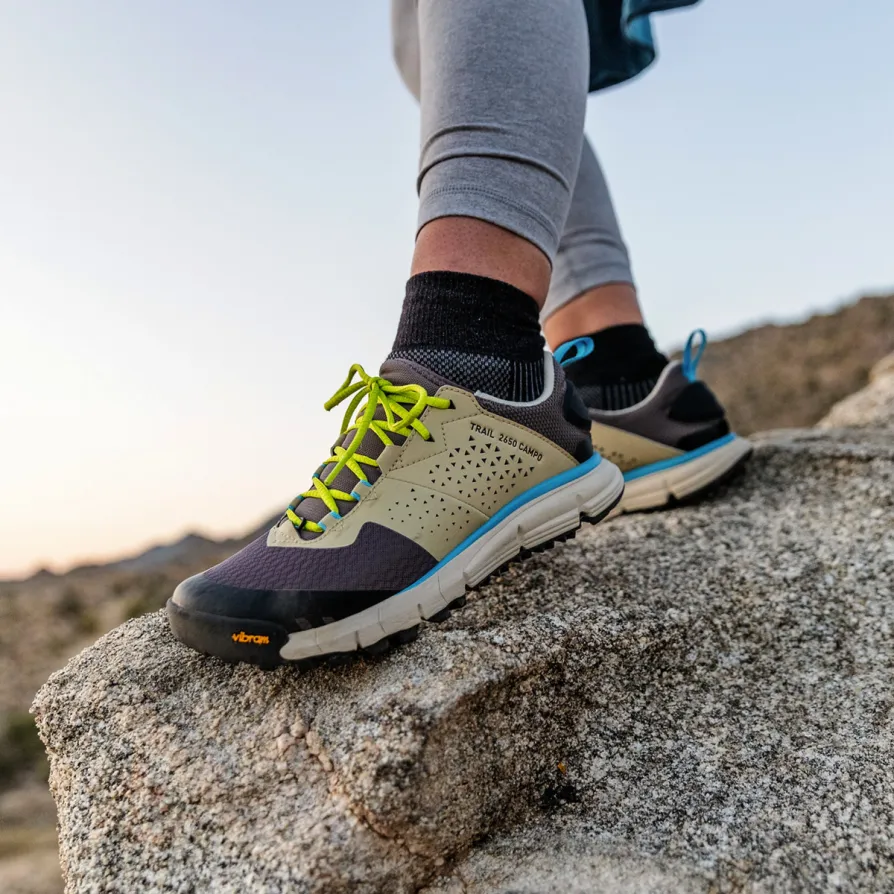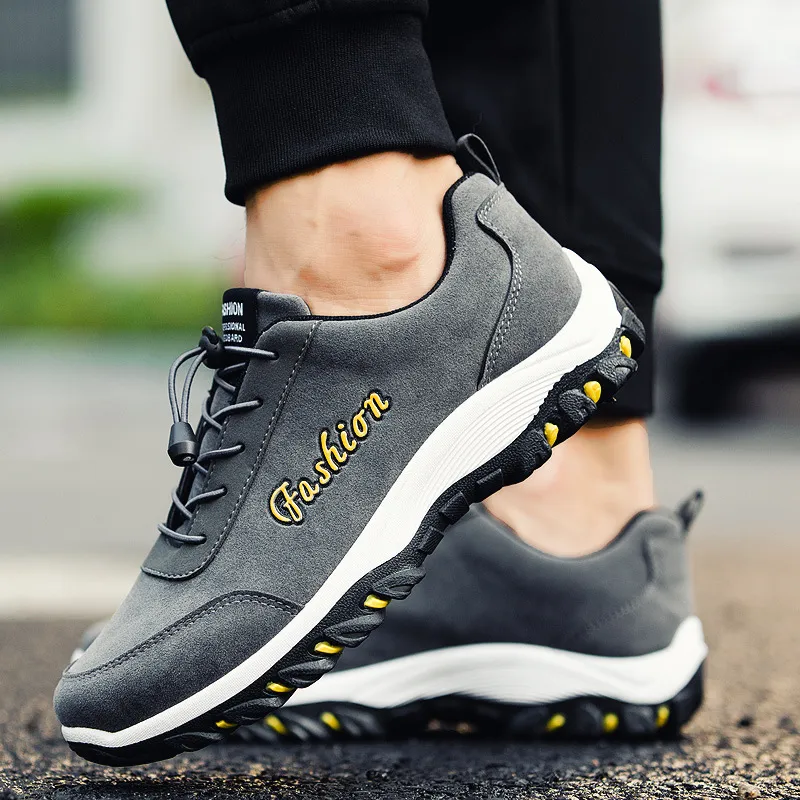Types of Hiking Shoes
Selecting the right category of hiking shoes is crucial for beginners. It lays the foundation for comfort and safety on your hikes. Here’s a breakdown of the main types you’ll encounter.
Trail Runners
For those starting with less rugged paths, trail runners make excellent options. They’re lightweight and offer more flexibility than traditional hiking boots. The best hiking shoes for beginners looking for speed and a natural feel of the trail will often find trail runners to be the ideal choice.
Light Hikers
If your adventures lead you to moderately challenging terrains, consider light hikers. These shoes strike a balance between support and agility. They are usually low-cut with stiffer midsoles than trail runners. They offer better stability without sacrificing too much comfort or adding extra weight.
Hiking Boots
When it’s time to tackle more demanding trails or carry a heavier load, hiking boots provide additional ankle support. With thicker soles and better traction, they’re designed for rougher terrains. Hiking boots are the best hiking shoes for beginners who prioritize protection and are planning to hike in varied and potentially inclement conditions.
Key Features to Look For
As you embark on the search for the best hiking shoes for beginners, focusing on several key features is essential. These characteristics will determine the overall performance and longevity of your footwear, ensuring a safe and enjoyable hiking experience.
Material and Durability
Initially, consider the material and durability of the shoes. Quality hiking shoes typically feature robust materials such as leather or synthetic fabrics. These materials resist wear and offer lasting support. Check the shoe’s construction; double-stitched seams and reinforced areas prone to stress should be present. Durability means your investment will stand the test of time and rough trails.
Traction and Grip
Next, assess the traction and grip. The sole’s design and material affect your stability on different terrains. Look for deep lugs and rubber soles that can handle mud, rocks, and roots safely. The right sole design helps prevent slips and falls, especially on wet or uneven surfaces.
Fit and Comfort
Fit and comfort are paramount. The best hiking shoes for beginners should hold your feet snugly without causing discomfort. Room for toes to wiggle is crucial for long walks. Also, look for padding around the collar and tongue, and a cushioned insole. These elements contribute to overall comfort during hikes.
Waterproofing vs. Breathability
Consider waterproofing and breathability. Waterproof shoes protect your feet in wet conditions but can lack breathability. Too much moisture inside your shoes can lead to blisters. Hence, find a balance. Shoes with water-resistant treatments and breathable fabrics are a good compromise.
Weight Considerations
Lastly, think about the weight. Lighter shoes won’t tire you out as fast, making them great for beginners. However, ensure they don’t compromise on support and protection for the sake of less weight. Strive for a balance between lightweight design and the structural integrity needed for hiking terrains.
Understanding Shoe Fit and Sizing
When it comes to hiking shoes, getting the fit right is essential for comfort and injury prevention. The right size and shape of the shoe can increase support and stability on uneven terrain. Due to the variety of hikes and foot shapes, understanding how to properly fit and size hiking shoes is a vital step for beginners. Properly fitted shoes can enhance your hiking experience from the very first trail.
Importance of Proper Fit
A proper fit is central to a good hiking experience. Shoes that are too tight can lead to blisters and discomfort, while those that are too loose might cause instability and increase the risk of ankle injuries. The best hiking shoes for beginners are those that fit snugly at the heel and instep, allow movement in the toe box, and hold your foot in place to prevent sliding on steep or rough terrain.
How to Measure Your Foot for Hiking Shoes
Measuring your foot accurately is the first step to finding out what size hiking shoe you need. Place a piece of paper on the floor against a wall, stand on it with your heel against the wall, and mark where your longest toe ends. Then, measure the distance from the edge of the paper to the mark. Repeat for both feet, and use the larger of the two measurements when selecting your size, as feet can differ in size.
Trying on Hiking Shoes
When trying on hiking shoes, do so in the afternoon when feet are typically swollen from the day’s activities, which can mimic how they’ll swell during a hike. Bring the socks you plan to hike in to ensure a true fit. Lace the shoes firmly but not too tightly, walk around, and try them on an incline if possible. This will help you feel any pinch points or slipping heels, which are signs the fit might not be right.
Finding the best hiking shoes for beginners means considering how the shoe fits and feels on your foot. If possible, visit a specialist store where knowledgeable staff can assist you. Remember, the right hiking shoes are the first step in your journey to becoming an avid hiker.
Hiking Shoe Care and Maintenance
Proper care extends the life of your hiking shoes, ensuring they’re ready for many trails.
Breaking In Your New Shoes
To break in your new hiking shoes, start with short walks. Gradually increase distance over time. This eases your shoes to fit your feet’s unique shape, preventing blisters. Wear the socks you’ll hike in for an accurate feel.
Cleaning and Storage
After each hike, clean your shoes of dirt and debris. Use a soft brush and mild soap. Let them air dry, away from direct heat. Store in a cool, dry place to prevent materials from breaking down.
When to Replace Your Hiking Shoes
Inspect your shoes often. Look for worn soles, damaged seams, or loss of support. If they cause discomfort or worse grip, it’s time for new ones. The best hiking shoes for beginners will need replacement after considerable wear to maintain performance.
Budgeting for Your First Hiking Shoes
Embarking on hiking adventures starts with investing in the best hiking shoes for beginners. It’s important to consider how much you’re willing to spend.
Estimating Cost and Keeping Within a Budget
Begin by researching average prices for beginner-level hiking shoes. Set a realistic budget that reflects the types of trails you plan to explore. Balance your spending with the essential features you need. Remember, investing in good footwear can prevent injuries and increase enjoyment.
Price vs. Quality Trade-offs
While budgeting, be aware of the price versus quality trade-offs. Lower-priced shoes may not provide the durability or comfort needed for longer hikes. On the other hand, the most expensive options may include features that a beginner hiker doesn’t need. Aim for a middle ground where the price aligns with quality, comfort, and long-term performance.
Top Recommended Hiking Shoes for Beginners
After covering the basics of hiking shoe types, features, and fit, it’s time to delve into some top recommendations. This section will help beginners pick out reliable and comfortable options within the market.
Overview of Popular Beginner Models
For beginners, several models stand out for their balance of comfort, durability, and price:
- Merrell Moab 2 Ventilator: A versatile and breathable shoe, ideal for dry conditions.
- Columbia Newton Ridge Plus II Waterproof: Offers great waterproofing finish, suitable for wet terrains.
- Keen Targhee II: Known for durability and toe protection, perfect for rocky paths.
- Adidas Terrex AX3: Lightweight with excellent grip, best for those who prefer swift hikes.
These models are praised for their comfort right out of the box, quality materials, and supportive designs.
What to Expect at Different Price Points
As you budget for your hiking shoes, here’s what beginners can generally expect at varying price points:
- Under $100: Basic functionality, adequate comfort, but potential trade-offs in durability.
- $100 to $150: Improved materials, better stability, and typically waterproof features.
- Above $150: High-end models with superior construction, advanced features like Vibram soles, and often, a more ergonomic fit.
Investing more can lead to a shoe that will last longer and provide a more comfortable and safe hiking experience. The best hiking shoes for beginners will be those that meet your needs while staying within your budget.
Additional Accessories for Hiking Comfort
Besides finding the best hiking shoes for beginners, consider accessories to boost comfort and protection. The right extras can enhance your hiking experience. Here are useful accessories to pair with your shoes.
The Role of Hiking Socks
Hiking socks play a vital role in protecting your feet. They cushion your soles and prevent blisters. Look for moisture-wicking material to keep feet dry. Choose socks that fit well with your shoes for best comfort.
Insoles and Orthotics
Insoles and orthotics provide extra support and improve shoe fit. They can help with foot alignment and prevent pain. Custom orthotics are best, but off-the-shelf insoles can also boost comfort for beginners.
Gaiters and Other Protective Gear
Gaiters keep debris out of your shoes and protect against scratches. Waterproof gaiters are great for wet conditions. Consider other gear, like trekking poles, for balance and support on tricky trails.





